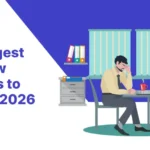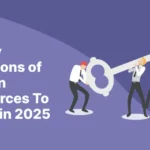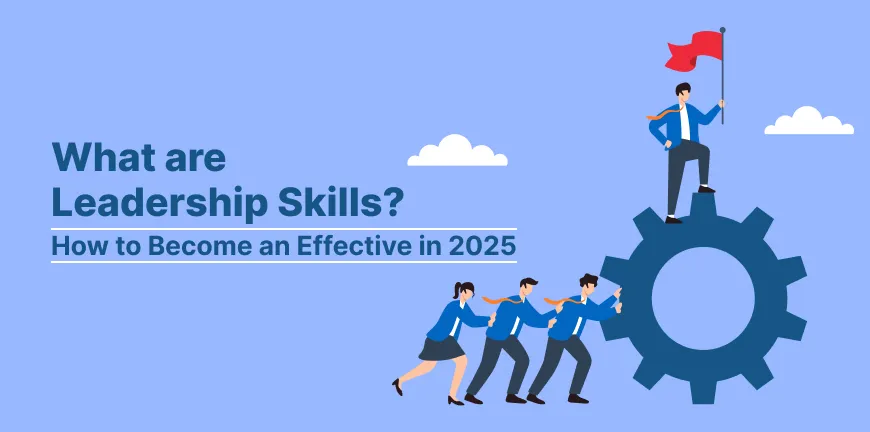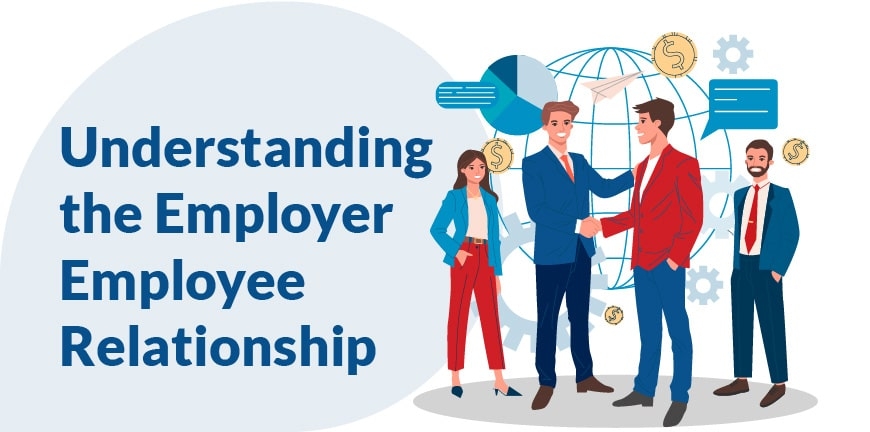
26+ Biggest Interview Mistakes (To Avoid in 2026)
13/10/2025
15 Key Functions of Human Resources To Know in 2026
13/10/2025- How Leadership Theory Evolved to Meet Business Demands
- Why Leadership Skills Matter More Than Ever in 2025
- The 11 Essential Leadership Skills That Drive Business Success in 2025
- Build and Strengthen Your Leadership Skills for 2025
- Address Critical Leadership Gaps That Hold Organizations Back
- Build Leadership Excellence That Drives Lasting Success
- Key Takeaways
- Conclusion
- FAQs
Strong leadership skills create measurable business results. Organizations with highly engaged leaders report 21% higher productivity and 41% fewer quality defects according to Gallup’s meta-analysis. The most striking finding: these productivity gains stem directly from leaders who invest in meaningful workplace relationships. Organizations preparing for 2025 face a rapidly evolving definition of effective leadership.
This leadership skills guide examines the essential leadership traits that will define successful leaders in 2025. We provide practical insights for developing these competencies and overcoming common leadership gaps that challenge today’s business environment.
How Leadership Theory Evolved to Meet Business Demands
Leadership understanding has undergone a remarkable transformation over the past century, with over 32,000 papers and 4,500 books published on leadership-related topics. This evolution reflects changing workplaces, shifting societal values, and a deeper understanding of human psychology and organizational dynamics.
The journey of leadership theory traces through distinct eras, each building upon previous frameworks. Initially, leadership operated under the Great Man Theory, which proposed that leaders are born with inherent characteristics destined for leadership. This evolved into Trait Theory, suggesting specific characteristics were necessary for effective leadership, regardless of whether leaders were born or made.
Research focus shifted from who the leaders were to what they accomplished. Behavioral Theory emerged, asserting that leadership effectiveness stemmed from actions rather than personality traits. This represented the first major shift in understanding leadership skills.
The next significant evolution recognized that leadership effectiveness depends on context. Contingency and Situational Theories proposed that there’s no one-size-fits-all approach to leadership, with effectiveness depending on various factors, including the leader’s capability, team skills, and work requirements. These theories acknowledged that different situations demand different leadership approaches.
Rapid change in the late 20th century necessitated new leadership frameworks. Traditional leadership styles, characterized by hierarchy, top-down decision-making, and rigid structures, became increasingly incompatible with a dynamic and interconnected world. This incompatibility arose from several key shifts:
- Modern employees value autonomy, purpose, and inclusiveness.
- Accelerating change demands agility and adaptability.
- Complexity requires collaborative problem-solving approaches.
- Inclusivity and belonging drive innovation.
- Digital and remote work reshape engagement models.
These shifts catalyzed what scholars call the “new leadership era,” moving away from traditional theories that defined leadership as unidirectional, top-down influence. The new leadership era introduced transformational leadership, which focuses on inspiring and motivating followers to exceed expectations. Leaders who adopt this style emphasize vision, innovation, personal development, and essential skills in today’s fast-paced technological industries.
Transactional leadership relies on authority, exchanging rewards for follower effort, and punishing failures. This approach works best in mature organizations with clearly defined structures and goals, where maintaining the status quo creates value.
Modern leadership continues evolving beyond these frameworks. Servant leadership has gained renewed popularity, emphasizing supporting team members and prioritizing their needs. Inclusive leadership focuses on empowering followers to become leaders themselves through person-centered approaches. Complexity leadership has emerged as a response to our increasingly intricate world, taking a whole-system view that considers contextual interactions across entire social systems.
Successful leadership increasingly requires balancing traditional and contemporary approaches. Today’s leaders face reconciling modern leadership styles with traditional leadership authority. Three critical areas distinguish contemporary leadership:
- Adaptability: Modern leaders remain open to new ideas and adjust strategies in response to evolving circumstances
- Innovation: Contemporary leadership fosters creativity and encourages teams to think beyond conventional approaches
- Inclusivity: Effective leaders recognize diverse perspectives and ensure all team members have a voice
This evolution continues as we approach 2025. Organizations like Allianz, Haier, Microsoft, and Nucor are transforming their industries with new organizational approaches that are open, fluid, and adaptable. These companies develop collaborative networks of self-managing teams that operate in rapid cycles and focus on creating stakeholder value.
Leadership evolution demonstrates that effective leadership skills continuously adapt to meet changing demands. Organizations preparing for 2025 benefit from understanding this evolutionary context when developing the leadership capabilities needed for future success.
Why Leadership Skills Matter More Than Ever in 2025
Business disruption has accelerated dramatically. Accenture’s 2024 Pulse of Change Index shows the rate of change increased by 183% over the past four years and 33% in 2023 alone. Moreover, effective leadership skills have moved beyond beneficial to absolutely essential for organizational survival and success.
Artificial intelligence creates a critical inflection point for leadership. A Financial Times analysis found that 374 companies in the S&P 500 mentioned AI on their earnings calls last year, with nearly nine out of ten describing it in glowing terms. Many leaders struggle to articulate concrete benefits beyond vague promises of “productivity gains,” revealing a leadership gap in technological vision and implementation.
Business complexity demands different leadership approaches. McKinsey researchers estimate that CEOs and top teams focused on four or five critical issues simultaneously ten years ago; that number has doubled today. This dramatic increase requires leaders who can navigate multiple priorities while maintaining strategic clarity and team cohesion.
Purpose-driven leadership creates a significant competitive advantage. Brands that prioritize purpose outperform the stock market by 120%, according to Harvard Business Review. Purpose-driven organizations enjoy 30% higher innovation rates and 40% better employee retention than their competitors. Leadership focused on meaningful outcomes drives both tangible and intangible results.
Employee expectations have evolved significantly. Research shows that 50-70% of an employee’s perception of their work environment links directly to management’s actions and behaviors. Leadership skills qualities impact organizational health in measurable ways:
- Leaders with high emotional intelligence foster company cultures where employees report significantly higher job satisfaction
- Managers with strong decision-making skills make more sound, rational choices affecting organizational direction
- Leaders skilled in conflict resolution spend less time managing workplace tensions, with the American Management Association reporting that managers devote at least 24% of their time to conflict management
- Leaders who effectively motivate their workforce reduce financial losses from absenteeism, attrition, and low productivity
The 11 Essential Leadership Skills That Drive Business Success in 2025
Today’s business environment demands specific leadership competencies that create measurable results. These 11 types of leadership skills have emerged as critical for leaders who want to excel in 2025 and guide their organizations through complex challenges.
1. Emotional Intelligence
Emotional intelligence ranks as the most critical leadership skill for 2025. Leaders with high EQ create more favorable organizational cultures, drive higher job satisfaction, and foster stronger employee engagement. This capability helps leaders recognize, understand, and manage emotions, both their own and others’.
Harvard Business School reports that 71% of employers value emotional intelligence more than technical skills when evaluating candidates. Leaders with strong emotional intelligence check their ego, listen attentively, and demonstrate genuine empathy, creating authentic connections with their teams.
2. Adaptability and Learning Agility
Business change accelerates at unprecedented rates, requiring leaders who adapt quickly to new circumstances. Learning agility: the ability to know what to do when you don’t know what to do, enables confident decision-making during uncertainty.
The World Economic Forum reports that learning agility and resilience have seen a substantial 17 percentage point increase in importance compared to previous years. Adaptable leaders anticipate challenges, welcome new opportunities, and help their organizations pivot effectively when circumstances shift.
3. Technological and AI Literacy
AI literacy stands out as a primary leadership skill shaping hiring and promotion decisions in 2025. C-suite executives have tripled AI literacy mentions in their profiles compared to just two years ago. Leaders are now 1.2 times more likely to learn these skills than other employees.
This capability extends beyond technical knowledge: effective leaders understand how AI drives business results, evaluate solutions based on actual outcomes, and recognize potential risks like bias and privacy issues. McKinsey projects that generative AI could add between INR 219.39 to 371.27 trillion annually to the global economy.
4. Strategic Thinking and Vision
Harvard Business Review research of 10,000 senior leaders shows 97% identified strategic thinking as the behavior most critical to their organization’s success. Despite this importance, 96% of those same leaders admitted they don’t have enough time for strategic thinking.
Strategic leaders possess a clear future vision and position technological initiatives alongside business goals to create real value. This skill requires looking ahead, assessing risks, and seizing opportunities before competitors act.
5. Effective Communication
Transparent communication boosts job satisfaction by 12 times, making it crucial for 2025 leadership success. Effective communicators reach different team members in ways that work for them, focusing on understanding rather than just responding. They share information about goals, challenges, and opportunities openly, creating environments where teams feel heard and valued. Remote work and hybrid arrangements make this skill even more essential for maintaining team cohesion.
6. Change Management
Change management has evolved from a specialized skill to a survival imperative for modern leaders. Research indicates 44% of organizations report greater focus on supporting workforce upskilling and reskilling in their leadership development programs. Leaders skilled in change management demonstrate empathy toward how transitions affect employees, coach teams through changes, and communicate transparently. They create safe spaces to experiment with new tools and address concerns early, helping organizations adapt while keeping teams engaged.
7. Creative and Analytical Thinking
Over 70% of surveyed companies identify creative and analytical thinking as skills most likely to grow in importance between 2023 and 2027. Despite advancing technology, creativity remains uniquely human. Successful leaders build environments that welcome innovative solutions and encourage teams to question current practices. They understand that diversity fuels innovation, as different viewpoints create settings where new ideas thrive and business solutions emerge.
8. Ethical Leadership
Ethical leaders make choices that benefit everyone—customers, communities, and employees alongside company growth. Six key principles shape ethical leadership: respect, accountability, service, honesty, justice, and community. These values guide decision-making and interpersonal interactions. Today’s focus on corporate responsibility makes honest, responsible leadership essential for lasting success and stakeholder loyalty.
9. Inclusive Leadership
Managing diversity and creating inclusive environments has become essential as workplaces grow more diverse and complex. Hybrid work, generational differences, and ethical debates around AI create new challenges for leaders. Harvard Business Review research found that 89% of respondents from various companies reported experiencing workplace polarization, spending approximately 3.5 hours weekly dealing with it. Inclusive leaders foster open dialogue, acknowledge different viewpoints, and maintain team alignment toward common goals.
10. Conflict Management and Polarization
Managing workplace conflict efficiently represents a core leadership responsibility. The American Management Association reports that managers spend at least 24% of their time managing conflict. The challenge extends beyond basic resolution to include deeper workplace divides. This requires fostering open dialogue, acknowledging different viewpoints, and maintaining team alignment despite differences. As one expert noted, “In a polarized world, the ability to hold space for nuance is a core leadership skill”.
11. Data-Informed Decision Making
Evidence-based decisions have become vital in today’s uncertain and technologically advanced business environment. Leaders need structured approaches to problem-solving based on objectivity and continuous learning. They must balance data insights with human judgment, knowing when to trust AI recommendations versus experience. The ability to quickly interpret insights helps turn raw data into applicable ideas without overwhelming team members with unnecessary analytics.
These eleven leadership skills for managers work together as an interconnected system of capabilities that reinforce one another. Emotional intelligence enhances communication, which improves change management effectiveness. Technological literacy strengthens data-informed decision-making, while ethical leadership supports inclusive practices across organizations.
Industry demand for these skills varies significantly. The Insurance and Pensions Management sector forecasts the fastest growth in creative thinking requirements, while Education, Training, and Telecommunications anticipate rapid growth in curiosity and lifelong learning. Leadership in 2025 requires balancing technological proficiency with deeply human capabilities.
Organizations that prioritize developing these eleven essential leadership skills position themselves for success in increasingly complex business environments. Leaders who focus on this skill set can navigate uncertainty, inspire their teams, and drive sustainable growth in the years ahead.
Build and Strengthen Your Leadership Skills for 2025
“Before you are a leader, success is all about growing yourself. When you become a leader, success is all about growing others.” — Jack Welch, Former Chairman and CEO of General Electric, an influential business leader.
Strong leadership capabilities require deliberate practice, self-awareness, and strategic growth opportunities. Many professionals mistakenly assume leadership abilities are natural talents rather than skills developed through structured effort. Studies confirm that intentional skill-building significantly outperforms natural talent alone in creating effective leaders.
1. Start with Self-Assessment
Accurate self-perception forms the foundation for leadership development. Begin by conducting a thorough self-assessment to identify your specific strengths and weaknesses. This process requires honesty and specificity, rather than general evaluations, pinpointing exact areas where you excel or struggle. Consider keeping a leadership journal to track successes and challenges over time, providing valuable insights into patterns and growth opportunities.
For a deeper understanding, use assessment tools like Myers-Briggs Type Indicator, DiSC Personality Assessment, or Emotional Intelligence evaluations. These frameworks help clarify your leadership style while establishing measurable benchmarks for improvement.
2. Seek Comprehensive Feedback
Beyond self-evaluation, 360-degree feedback provides an invaluable perspective. This approach gathers input from supervisors, peers, direct reports, and even clients or suppliers to create a complete picture of your leadership effectiveness. Tools like Benchmarks® 360 assessments offer structured frameworks for collecting and analyzing multi-source feedback.
The power of this method lies in its comprehensive nature—you gain insights from various stakeholders who experience your leadership differently, creating a nuanced understanding of your impact across contexts. This feedback foundation enables targeted development based on real perceptions rather than assumptions.
3. Design Strategic Development Plans
Once you’ve established baseline awareness through assessment and feedback, create a personalized leadership development plan. Effective plans should:
- Identify specific leadership competencies to develop.
- Establish clear, measurable objectives.
- Select appropriate development methods.
- Set realistic timeframes.
- Include progress evaluation metrics.
This structured approach ensures your development efforts remain focused and intentional rather than scattered. According to Harvard DCE, successful leaders map targeted improvement plans to boost strengths and address gaps in experience and skills.
4. Choose Appropriate Development Methods
Different leadership skills require different development approaches. Consider these evidence-based options:
- Formal Training Programs: Organizations report that 44% are placing greater emphasis on supporting workforce upskilling and reskilling in leadership development programs. These structured experiences provide specific knowledge and practical insights into effective leadership practices.
- Mentorship and Coaching: Pairing with experienced leaders offers practical learning through observation and guided practice. Executive coaching provides personalized support, helping leaders overcome challenges and maximize potential.
- Action Learning Projects: Real-world projects addressing business challenges allow practical application of leadership skills. Wilson Learning research shows versatile leadership can drive up productivity and engagement by as much as 56%.
- Cross-functional Experiences: Leading projects across departments exposes you to diverse perspectives and enhances leadership versatility.
- Community Engagement: Volunteer work develops empathy, social responsibility, and servant leadership qualities essential for inspiring others.
5. Use Technological Resources
Modern leadership development increasingly incorporates technology-driven solutions. AI-powered platforms provide personalized coaching experiences, real-time feedback, and data-driven insights into leadership effectiveness.
Digital tools offer significant advantages:
- Scale leadership development across organizations.
- Provide consistent quality and methodology.
- Enable on-demand learning that fits busy schedules.
- Track progress through analytics and reporting.
- Connect learning directly to workplace applications.
6. Build Continuous Learning Habits
Leadership development thrives on continuous learning. Dedicate time weekly to leadership-focused content through books, podcasts, and industry blogs. As one Harvard expert notes, “The idea of continuous learning and continuous development and continually trying is an important trait of leaders. Organizations that are continuous learning organizations tend to be more effective than those that aren’t”.
7. Practice in Real Situations
Theory alone rarely builds leadership competency. Look for opportunities to practice newly acquired leadership and management skills in workplace scenarios. Start with smaller leadership responsibilities before progressing to more complex situations. Each experience provides valuable learning if approached with reflection and improvement intent.
A practical approach involves breaking down leadership competencies into component behaviors. Dr. Wanda Wallace of the Leadership Forum advises: “Every competency has a host of behaviors that make that competency real. Teach the specific, actionable components. For example, giving feedback is about observing the team member, getting comfortable delivering a hard message, being able to manage emotions, and knowing when to coach and when to wait”.
8. Create Organizational Support Systems
Organizational culture significantly impacts leadership development effectiveness. The most successful leadership initiatives receive broad, sustained support from senior leaders who model desired behaviors. HR teams increasingly focus on building top-down, organization-wide support for learning across all levels, making it part of each leader’s job and creating an overall culture of learning.
Leadership development should align with business priorities and performance outcomes. Programs linked to specific business goals, like revenue increase or innovation, demonstrate significantly higher effectiveness rates. Importantly, leadership learning experiences should vary by level, recognizing that different leadership positions require distinct capabilities and approaches.
Following these evidence-based development strategies and leadership skills examples will help you build the essential leadership skills needed to excel in today’s complex business environment.
Address Critical Leadership Gaps That Hold Organizations Back
Organizations face a stark reality: 80% report that current business challenges require different leadership styles, yet only 21% say their leadership practices are effective. This reveals a widespread inability to build necessary leadership skills. More concerning, 46% of organizations place little or no priority on leadership development.
Research identifies five critical leadership skill deficiencies: strategic planning, change management, knowledge sharing, listening, and emotional intelligence. These gaps create measurable impacts on organizational performance and employee engagement. Teams led by managers lacking these skills experience reduced motivation, higher turnover, and diminished productivity.
Several factors contribute to these leadership deficiencies. The trends most strongly associated with large skills gaps include:
- Selection and reward practices that encourage outdated leadership styles.
- Leaders are resistant to changing their approach.
- Underinvestment in leadership development.
- Business challenges require different leadership styles.
External trends compound these challenges: unpredictable events, reduced employee tenure, aging workforce, and millennial employee expectations.
Leadership weaknesses show up in specific problematic behaviors. Leaders who micromanage demonstrate a lack of trust in their teams, ultimately decreasing employee motivation. Those who fail to set clear expectations leave employees unsure about objectives, creating misalignment with business goals. Ineffective feedback further undermines performance, as employees remain unaware of their strengths and development areas.
Organizations can narrow these gaps through specific practices. Companies with smaller skills gaps develop leadership capabilities across all employees rather than just designated leaders. They utilize leadership competency models, implement formal development programs for high-potential staff, and base compensation on performance.
Professionals can overcome leadership weaknesses through these strategic steps:
- Identify specific weaknesses – Use self-assessment and 360-degree feedback to pinpoint development areas
- Implement improvement strategies – Create targeted plans addressing specific gaps
- Actively seek feedback – Regularly gather input from team members and peers
- Make necessary adjustments – Refine approaches based on feedback received
- Evaluate progress consistently – Track improvement through measurable benchmarks
Organizations benefit from creating supportive environments for leadership development. Leadership capabilities should be developed across all employees rather than limiting development to designated leaders. This approach provides a larger talent pool and empowers all staff to act as leaders when needed, enabling quicker responses to unpredictable events.
One practice shows a significant association with larger skills gaps: substantial differences between leader compensation and other employees. This suggests excessive pay disparities may undermine leadership effectiveness.
Current business challenges require sustained investment in leadership development. Organizations that prioritize addressing these common leadership gaps gain a competitive advantage both now and in the future.
Build Leadership Excellence That Drives Lasting Success
Leadership excellence forms the foundation of organizational success in today’s business environment. The shift from traditional management approaches to adaptive leadership frameworks reflects the changing demands that define modern workplaces. Mastering these eleven essential leadership skills positions professionals to excel in 2025 and create sustainable competitive advantages.
Emotional intelligence creates the foundation for building productive teams where people feel valued and motivated to perform at their best. Adaptability and learning agility enable leaders to navigate uncertainty while maintaining team confidence during periods of change. Technological literacy, particularly around AI applications, provides the knowledge base for making informed decisions that drive real business value.
Strategic thinking, effective communication, and change management work together to help leaders create clear direction, share it effectively, and guide teams through necessary transitions. Creative thinking, ethical leadership, inclusivity, conflict management, and data-informed decision making complete the skill set required for sustained leadership success.
These capabilities require intentional development through systematic assessment, targeted feedback, structured improvement plans, and consistent practice. Leaders who invest in developing these competencies create organizations that respond quickly to market changes and maintain employee engagement during challenging periods.
The gap between required and existing leadership competencies presents both challenge and opportunity. Organizations that develop leadership capabilities across all team members, rather than limiting development to designated leaders, build stronger, more resilient operations capable of handling unexpected business challenges.
Leadership excellence will separate thriving organizations from those that struggle to adapt. The path toward leadership mastery demands commitment and ongoing development, yet delivers substantial returns through improved team performance, stronger organizational culture, and better business results.
Successful leaders of 2025 balance technological knowledge with human-centered capabilities. They demonstrate both analytical skills and emotional awareness. Most importantly, they approach leadership as an ongoing journey of growth and improvement—continuously developing their abilities to meet new challenges and seize emerging opportunities in our dynamic business landscape.
Key Takeaways
- Emotional intelligence remains the top leadership skill, with 71% of employers valuing it over technical skills and creating 21% higher productivity in engaged teams.
- AI literacy has become essential for leaders, with C-suite executives tripling AI mentions in profiles as generative AI could add $219-371 trillion annually to the global economy.
- Strategic thinking and adaptability are critical, as leaders now manage twice as many priorities as a decade ago while navigating 183% faster change rates.
- Leadership gaps are widespread but addressable – only 21% of organizations report effective leadership practices, yet companies developing all employees as leaders show smaller skill gaps.
- Development requires intentional practice through 360-degree feedback, structured plans, and real-world application rather than relying on natural talent alone.
Conclusion
Mastering leadership skills in 2025 is no longer optional: It’s essential for thriving in an era defined by rapid change, AI disruption, and complex workplace dynamics. This leadership skills guide provides a practical roadmap to build future-ready leadership capabilities that drive innovation, engagement, and organizational resilience.
By understanding and applying these 11 essential skills, professionals and businesses can bridge critical leadership gaps, foster stronger teams, and gain a competitive edge. Read this guide to lead with impact and shape tomorrow’s success.
FAQs
1. What are the most crucial leadership skills to develop for 2025?
The top leadership skills for 2025 include emotional intelligence, adaptability, technological literacy (especially AI), strategic thinking, and effective communication.
2. How is leadership expected to evolve by 2025?
Leadership in 2025 is expected to be more adaptive, inclusive, and technologically savvy. Leaders will need to balance human-centered skills with technological proficiency, embrace collaborative approaches, and lead from the center rather than the top.
3. Why are leadership skills becoming more important than ever?
Leadership skills are increasingly crucial due to rapid technological changes, increased workplace complexity, and evolving employee expectations. The importance of leadership skills is such that it directly impacts organizational success, with highly engaged leaders showing 21% higher productivity and 41% fewer quality defects.
4. How can leaders develop and strengthen their skills for 2025?
Leaders can improve their skills through self-assessment, seeking comprehensive feedback, designing strategic development plans, and choosing appropriate learning methods such as formal training, mentorship, and action learning projects.
5. What are the common leadership gaps, and how can they be addressed?
Common leadership gaps include strategic planning, change management, knowledge sharing, listening, and emotional intelligence. To address these gaps, organizations should develop leadership capabilities across all employees, implement formal development programs, and create supportive environments for leadership growth.
Contact Us For Business Enquiry

Rajkumar Shanmugam
Rajkumar Shanmugam is the Head of HR at ALP Consulting, bringing over 19 years of comprehensive HR leadership experience across India and international markets. His expertise spans talent acquisition, employee relations, performance management, compliance, and HR transformation. Rajkumar has a proven track record of driving people-centric initiatives, enhancing workplace culture, and aligning HR strategy with business goals. With extensive experience in US staffing operations and global mobility, he continues to lead organizational excellence through innovation and employee engagement.




